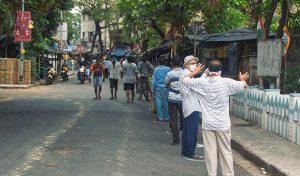The number of active cases of COVID-19 has been steadily reducing since late September 2020 and it was then that most public places, schools, colleges and offices began opening their doors for regular operation.
Despite this, COVID protocols were being maintained with the utmost scrutiny in all such public places. As of February 2021, more than half of all the Indian states reported that there was not a single death due to COVID-19 and this ushered in some much-needed hope.
However, recent studies conducted by scientists at Delhi, using a mathematical model have examined that cases will be at a peak around 20th April 2021.
Leading Indian scientists from the most renowned institutes and research centres have suggested that 2 distinctive factors can be used to trace this sudden and sharp rise of active cases in India.
In the case of a coronavirus variant, it may take time for the mutated virus to spread, depending on how contagious it is. A very transmissible variant such as delta can cause a faster acceleration in new cases leading to waves.
Dr. M.G. Kartheeka, MBBS, MD
With such a sharp rise in new cases of COVID-19, the states of Maharashtra, Karnataka, Tamil Nadu, Delhi, Haryana and Uttar Pradesh have been marked to be high-risk states that are already experiencing the effects of the Second Wave.
Despite the rapid testing and the extensive vaccination drives undertaken by the government, the daily caseload of infected people is averaging at around 55,000 as opposed to the few couple thousand last year.
The second wave of Covid was more severe than the first wave and is attributed majorly to insufficient vaccinations and human behaviour of not following covid appropriate behaviour. Following appropriate measures for Covid will be very essential to prevent any further outbreaks.
Dr. Ashish Bajaj – M.B.B.S, M.D.
Many states like Gujarat, Maharashtra, Haryana and Punjab have been counting the number of cases peaking either equal to or more than their earlier records from the previous year. Although states like West Bengal, Andhra Pradesh, Bihar and Uttar Pradesh are likely to be still in the infant stages of the Second Wave, state governments have ramped up their testing and inoculation drives. Scientists expect this Second Wave to last more than 2 or 3 months, given the progress of vaccinations of a population that is 1.3 billion strong.
Manindra Agarwal of IIT Kharagpur who is famous for pioneering the ‘Super Model’ has stated that this Second Wave is most likely to see a sharp fall following April. Nevertheless, taking comfort in the low death rates is not the way to go and we should all follow the stipulated COVID protocols whenever venturing out.
With these alarming situations around, take good care of your health with regular checkups through PharmEasy!

Disclaimer: The information provided here is for educational/awareness purposes only and is not intended to be a substitute for medical treatment by a healthcare professional and should not be relied upon to diagnose or treat any medical condition. The reader should consult a registered medical practitioner to determine the appropriateness of the information and before consuming any medication. PharmEasy does not provide any guarantee or warranty (express or implied) regarding the accuracy, adequacy, completeness, legality, reliability or usefulness of the information; and disclaims any liability arising thereof.
Links and product recommendations in the information provided here are advertisements of third-party products available on the website. PharmEasy does not make any representation on the accuracy or suitability of such products/services. Advertisements do not influence the editorial decisions or content. The information in this blog is subject to change without notice. The authors and administrators reserve the right to modify, add, or remove content without notification. It is your responsibility to review this disclaimer regularly for any changes.
The lockdown implemented to enforce social distancing and contain the spread of COVID-19 will possibly be eased gradually. At present, many restrictions are already being eased all over the country. However, this has led to an increase in the number of cases in India. Experts fear that there might be a second wave of COVID-19 arriving soon.
A second wave means a surge in the number of COVID-19 cases after there has been a decline. It has already happened in China, where cluster infection has been reported recently even after weeks of no new diagnosed cases. It is possible that other countries including India will also witness a similar trajectory.
It is difficult to pinpoint exactly when the second wave will arrive. But epidemiologists and healthcare professionals feel it will happen in the July-August period.
As the lockdown is slowly being relaxed, people have started going out. All economic activities are resuming. More and more people will be joining their workplace. Shopping centres and shops will open, and thousands will flock to the stores to make essential and non-essential purchases. Movie theatres and malls, if opened, too will attract crowds. People have been confined for so long that they will want to meet with their acquaintances and friends.

If the lockdown is eased further, we can assume that for the whole of June, people will be mingling with each other. Some of these people might be infected and will pass on the coronavirus to those they come in contact with.
Going by this trend, new people will start getting infected during June, and fresh cases will be reported from the end of June or July onwards. The second wave is very likely to happen.
Studies have shown that previous infection was highly protective against reinfection with alpha, beta and delta variants, but less so against omicron, BA. 1. A previous infection provided moderate protection from reinfection with omicron BA. 1 (45%), compared with stronger protection against pre-omicron variants (82%).
Dr. Ashish Bajaj – M.B.B.S, M.D.
It is not possible to confirm if the second wave will arrive or not, so it is best to be prepared. The government and the citizens have to be extremely cautious. What we do now will decide how dangerously the second wave will be.
1. Maintain social distancing when you go out.
2. Do not go out unless necessary, even after the lockdown is lifted.
3. If you are going back to the office, use hand sanitisers, hand wash and face masks all the time.

4. Do not gather in groups anywhere, including the office.
5. Keep your workstation disinfected.
6. Do not shake hands with clients.
7. Opt for e-conferences.
8. Continue to work from home wherever possible.
9. Wash your clothes and disinfect your office bag after coming home, don’t let others come in contact with your stuff.
10. Continue following certain lockdown measures like cleaning up groceries, fruits, vegetables, food packets, etc.
11. Eat healthily and keep exercising to boost immunity.
Governments (both State and Union) are doing the following –
Only by being cautious can we keep our loved ones and ourselves safe from the second wave.
Remember, step out only when necessary to stay protected at all times.
Disclaimer: The information provided here is for educational/awareness purposes only and is not intended to be a substitute for medical treatment by a healthcare professional and should not be relied upon to diagnose or treat any medical condition. The reader should consult a registered medical practitioner to determine the appropriateness of the information and before consuming any medication. PharmEasy does not provide any guarantee or warranty (express or implied) regarding the accuracy, adequacy, completeness, legality, reliability or usefulness of the information; and disclaims any liability arising thereof.
Links and product recommendations in the information provided here are advertisements of third-party products available on the website. PharmEasy does not make any representation on the accuracy or suitability of such products/services. Advertisements do not influence the editorial decisions or content. The information in this blog is subject to change without notice. The authors and administrators reserve the right to modify, add, or remove content without notification. It is your responsibility to review this disclaimer regularly for any changes.